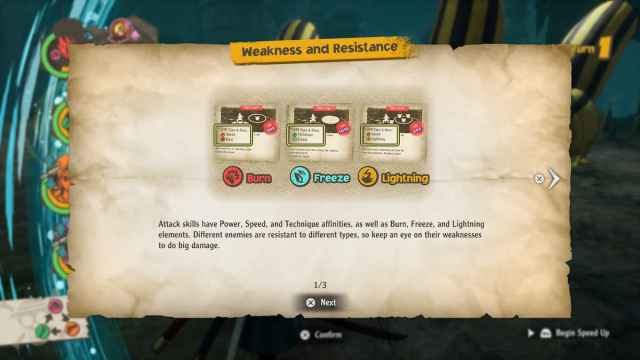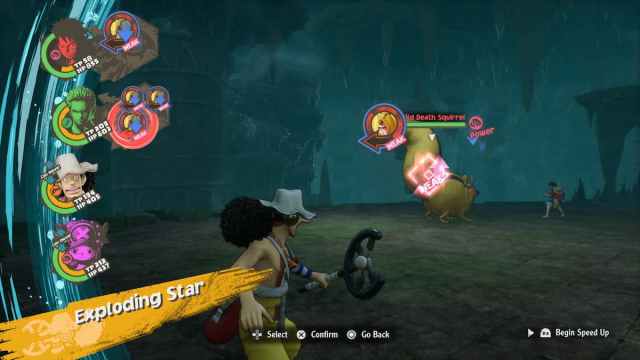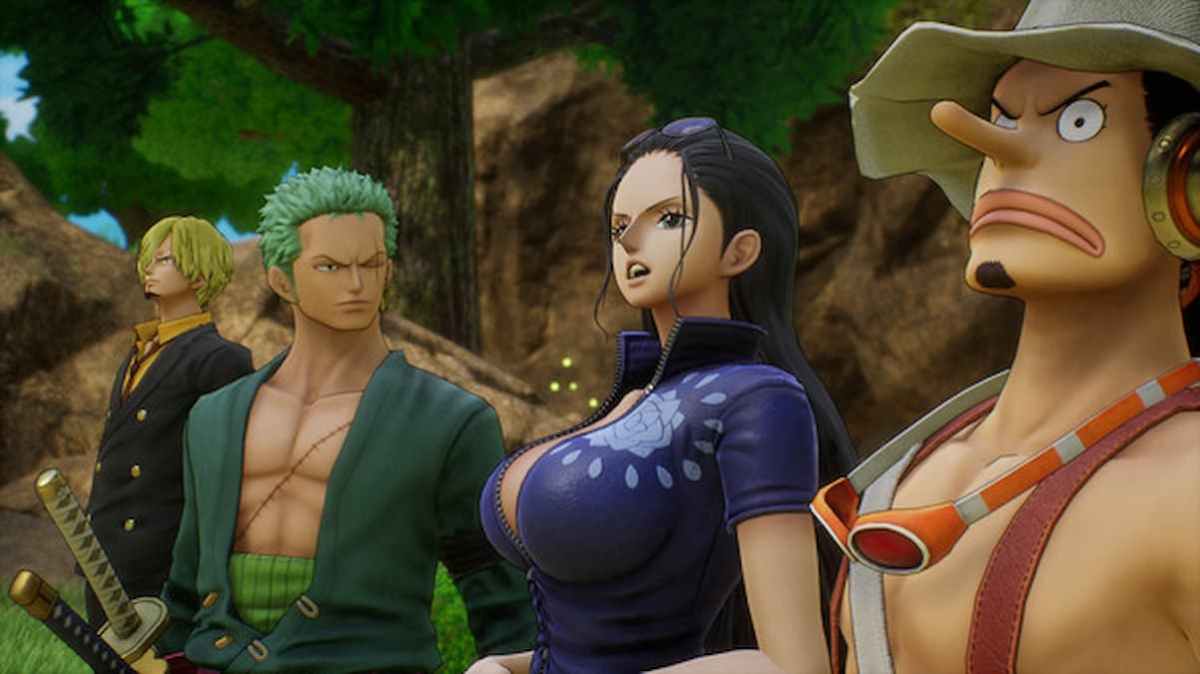A baby game, for babies
One Piece Odyssey is a very easy game. There’s a good reason for that – despite its frequently thoughtful writing and near-constant horniness, One Piece is ultimately a series aimed at children. It makes sense that a One Piece video game would try its best to remain accessible to its younger audience.
It also makes sense for older fans to hear “comically easy turn-based game” and immediately reach for the auto-battle button. Luckily, One Piece Odyssey has a great auto-battle system. As long as you’re not actively avoiding combat, the computer will probably be able to get you through most fights (bosses included) without issue.

But I’m here to ask you to reconsider. Yes, auto-battle will get you through most of Odyssey‘s skirmishes, but if you have any love for turn-based RPGs, you owe it to yourself to check out this combat system.
Uncommon (and unnecessary) depth
I am saying this with full sincerity: One Piece Odyssey has the best turn-based combat since Shin Megami Tensei V. At first blush, it’s got a pretty basic rock-paper-scissors type-matching system. Power fighters are strong against Speed opponents, Speed fighters are strong against Technique opponents, and Technique fighters are strong against Power opponents. There are also elemental attacks with their own rudimentary type chart, and a clever (if played-out) system where normal attacks build resources to execute special attacks. But Odyssey‘s great strength lies in its positioning mechanics.

One Piece Odyssey features a fairly simple positioning system. There are a few different areas, and each party member and enemy is assigned to one of them. If there are no enemies in an area, then party members in that area can move to any other area without issue. If there are enemies in an area, then party members can only switch places with other party members who haven’t acted yet. That means once you’ve used one character, they can’t move until the turn ends.
This leaves the door open for all sorts of interesting challenges. Say there are two areas full of Power enemies – for a good chunk of the game, you’ll only have two Technique fighters, Zoro and Nico Robin. Zoro is stronger, so it’s easy to wipe out all the enemies in one area, but Nico Robin’s area of attack moves are pretty awful. You could send Luffy, a Power fighter, to her area to help out, but you might be leaving another area undefended, and another party member open to attack.
Brain teasing
Usually, the solution to these problems is pretty obvious. Luffy, for instance, can probably leave Robin to fend for herself – if she can’t pull things off this turn, the generally low health bars on those enemies will be whittled down on the next turn, and most enemies deal pretty negligible damage. It’s fun to try and min-max these turns, but it’s never really rewarded. After all, the game really is a cake walk. If you wanted to ignore most of its systems and just press the “Attack” button, you would probably win 70% of the fights, and if you’re thinking about type-matching at all, you’ll almost never face a real roadblock.

Sometimes, though, Odyssey will throw a special challenge your way. It’s usually not too difficult on its own; “Beat [x] enemy with Chopper,” “Clear the area before Usopp is knocked out,” something to that effect. But it turns the game on its head, particularly if you’ve been playing normally for a little while.
Here’s an example – during one minor boss fight, I was asked to beat a boss with Luffy. This threw a wrench into my plans. Luffy is a Power fighter, and the boss was a Technique fighter, so I had the type disadvantage. That meant it was really tough to put a dent in its health bar with Luffy alone, so I whittled it down with a couple other party members while Sanji single-handedly defended another area. Eventually, I had it in a very frustrating spot. One attack from Luffy probably wouldn’t have killed it, but an attack from anyone else absolutely would have. This is when I remembered Trick Balls, the craftable consumables that serve almost no purpose in regular play. Using Trick Balls on the enemy lowered its defense, allowing me to deal the finishing blow as Luffy.
This is an example of Odyssey encouraging me to play with its systems, to find the synergies that I would otherwise ignore. It’s a common game design tactic, but a playful and effective one. More importantly, it would have had absolutely no impact if I had just been auto-battling up to that point.
The case for auto-battle
Let me clarify something: those challenges I was talking about are optional. If I wanted to, I could have left Luffy out of that fight entirely. There’s no punishment for failing those mini-tasks, and the rewards are pretty meaningless after the first couple of hours. I enjoy playing with these systems because I already like Odyssey‘s combat. And I am not everybody.

There are those for whom all of this will sound very tedious. If you can just muscle through without paying attention to all the interlocking systems, without thinking about character positions or type advantages, why would you expend the extra brainpower just to beat an ostensibly pointless challenge? I understand this philosophy entirely, and I’m glad that auto-battle is there for people who feel this way. One Piece Odyssey has a lot of great stuff to offer for both long-time One Piece fans and total newcomers, and it would be a huge bummer if people were locked out of that stuff by a combat system that they find boring.
But if you think you’re the kind of person who will bounce off of Odyssey‘s combat, I implore you to at least give it a try. There’s more to it than you might have guessed, and while it doesn’t demand a lot of attention, it does benefit from it.






Published: Jan 18, 2023 03:00 pm